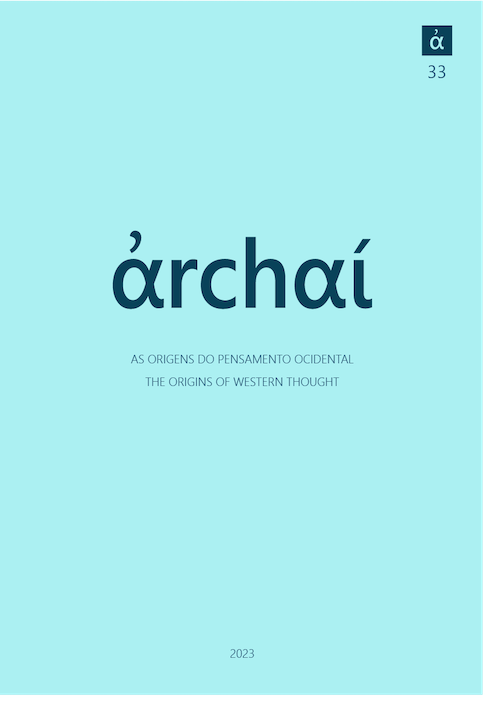La botte piena o la moglie ubriaca?Wine and gender in ancient Rome.
DOI:
https://doi.org/10.14195/1984-249X_33_09Keywords:
Ancient Rome, Wine, GenderAbstract
The ways in which each society or group considers alcohol consumption and its effects in multiple cultural contexts is quite different, especially when the discourses refer to this consumption with attention focused on gender. Thus, the associations between the consumption of alcoholic beverages and changes in the sexual behavior of each gender, although present since antiquity, must be understood within the cultural contexts in which they were produced, to understand how each social group deals with certain situations. physiological aspects and from this builds its discourses and interdictions. In this way, a careful return to ancient sources becomes essential, avoiding interpretations based on common sense or tradition, considering the possible differences between normative discourse and everyday practice.
Downloads
References
BABBITT, F. C. (1962) Plutarch. Moralia. Volume IV. Cambridge, Harvard University Press. (1ed. 1936).
CARY, E. (1960). Dionysius of Halicarnassus. The Roman Antiquities. Volume I. Cambridge, Harvard University Press. (1ed. 1937)
FOSTER, E. S.; HEFNER, E. H. (1993). Columella. On Agriculture X-XII. Cambridge, Harvard University Press. (1ed. 1955)
GOUJARD, P. (1975). Caton. De L’Agriculture. Paris, Les Belles Lettres.
RACKHAM. H. (1960). Pliny. Natural History. Volume IV, Libri XII-XVI. Cambridge, Harvard University Press. (1ed. 1945)
ROLFE, J. C. (2016). Aulus Gellius. The Complete Work of Aulus Gellius. Hastings, Delphi Classics.
SCHICK, C. (1955). Polibio. Le Storie. Volume II. Roma, Mondadori.
Referências
BILLIARD, R. (2013). Vins, Viticulture, la vigne dans la Antiquité. Lyon, Librarie H. Lardanchet.
CANTARELLA, E. (1996). I supplizi Capitale in grecia e a Roma,. Origini e funzioni delle pene di morte nell’antichitá classica. Milão, Biblioteca Universale Rizzoli.
CANTARELLA, E. (2013). L'Ambiguo Malanno. Condizione e immagine della donna nell'antichità greca e romana. Milão, Feltrinelli.
CAVICCHIOLI, M. (2020). O incesto e o monstro: Uma construção da memória do Imperador Calígula. In: História (São Paulo), Dossiê Memórias e Mortes de Imperadores romanos (I a.C. – VI d.C.) v. 39.
CAZANOVE, O. (1987). ”Exesto”: L'incapacité Sacrificielle des Femmes à Rome (À Propos de Plutarque "Quaest. Rom." 85). In: Phoenix. Vol. 41, No. 2 , p. 159-173. Disponível em: http://www.jstor.org/stable/1088742 Acessado em 31/08/2021.
COLE-HARDING, S.; WILSON, J. R. (1987). Ethanol metabolism in men and women. In: J Stud Alcohol. Vol. 48, p. 380-7.
COLONNA, G. (1978). Popoli e Civiltà dell’Italia Antica. Roma, DArchi.
DE GIOVANNI, C. (2017). Fraseologia e paremiologia. Passato, presente, futuro. Serie: METODI. Roma.
DUBOWSKI, K. M. (1985). Absorption, distribution and elimination of alcohol: Highway safety aspects. In: Journal of Studies on Alcohol. Suppl. 10, p. 98-108.
DUHART, F. (2019). Bebidas con identidad. Elementos para una antropología del beber. Analíticos. Vol. 1, p. 31-47.
GRAS, M. (1983). Vin et société à Rome et dans le Latium à l'époque archaïque. In: Modes de contacts et processus de transformation dans les sociétés anciennes. Rome, École Française de Rome, p. 1067-1075. Disponível em: http://www.persee.fr/doc/efr_0000-0000_1983_act_67_1_2501 Acessado em 16/05/2020.
HENDRY, J. (2020). Drinking and Gender in Japan. In McDONALD, M. Gender, Drink and Drugs. Oxfordshire, Routledge.
MENÉNDEZ, E. L. (2013). Prefácio. In: SOUZA, M. L. P. Processos de alcoolização Indígena no Brasil: perspectivas plurais [online]. Rio de Janeiro: Editora FIOCRUZ.
NOAILLES, P. (1937). Les tabous du manage dans le droit primitif des Romains, dans Annales Sociologiques, série C, fase. 2.
PHILLIPS, R. (2003). Uma Breve História do Vinho. São Paulo: Editora Record.
PURCELL, (1994). Wine and Wealth in Ancient Italy. The Journal of roman Studies, vol. 75, p. 1-19.
RUSSEL, B. (2003). Wine, Women, and the Polis: Gender and the Formation of the City-State in Archaic Rome. Greece & Rome., Vol. 50, n. 1. Cambridge: Cambridge University Press, p. 77-84. Disponível em: http://www.jstor.org/stable/3567821 Acessado em 19/09/2020.
WILSNACK, R. W.; WILSNACK, S. C.; KRISTJANSON, A. F.; VOGELTANS-HOLM, N. D.; GMEL, G. (2009). Gender and alcohol consumption: patterns from the multinational GENACIS project. Addiction. Vol. 9, p. 1487-1500.
ZEVI, F.; BARTOLONI, G.; CATALDI, M. D. (1977). Aspetti dell’ideologia funeraria nella necropoli di Castel di Decima. In: GNOLI, G. E.; VERNANT, J. P. La mort, les morts dans les sociétés anciennes. Paris: Éditions de la Maison des sciences de l’homme.
Downloads
Published
How to Cite
Issue
Section
License
Copyright (c) 2023 Marina Régis Cavicchioli

This work is licensed under a Creative Commons Attribution 4.0 International License.
Given the public access policy of the journal, the use of the published texts is free, with the obligation of recognizing the original authorship and the first publication in this journal. The authors of the published contributions are entirely and exclusively responsible for their contents.
1. The authors authorize the publication of the article in this journal.
2. The authors guarantee that the contribution is original, and take full responsibility for its content in case of impugnation by third parties.
3. The authors guarantee that the contribution is not under evaluation in another journal.
4. The authors keep the copyright and convey to the journal the right of first publication, the work being licensed under a Creative Commons Attribution License-BY.
5. The authors are allowed and stimulated to publicize and distribute their work on-line after the publication in the journal.
6. The authors of the approved works authorize the journal to distribute their content, after publication, for reproduction in content indexes, virtual libraries and similars.
7. The editors reserve the right to make adjustments to the text and to adequate the article to the editorial rules of the journal.



